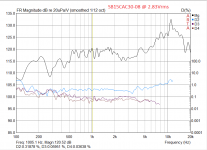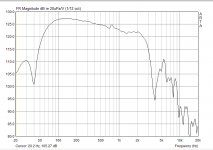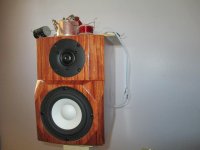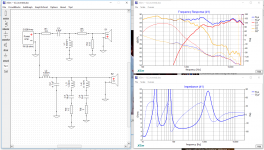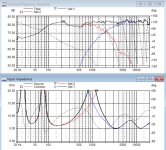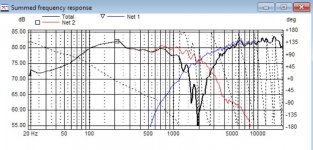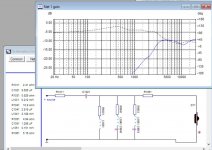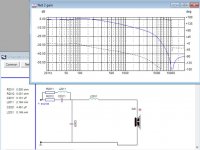A smallish update. Those CAC drivers are very good
Hi Borys, did that lower mid bump on the manufacturers graph show up when measuring this driver?
Here is my version of the CAC5.5 and the dimple dome. Baffle is 300mm x 200mm. Volume is about 10liters. I use my own extreme version of 12db roll off. I could do a more conventional 24db but don't like extra inductor on the 3rd electrical. My initial impression awhile back when I first listened is that the midrang sounds a bit "dead". But the xover was not optimized at 3khz since after 2khz, there is really nothing left of this driver. This current version takes the xover to 2khz with a 1.8mh inductor which is probably the biggest of any 2way system on the planet. Whoever designed this driver probably got some big ego.
Anyway, as for the sound, for the most part, it's not bad. Good detail, good composure at high volume, fairly deep soundstage. But and I think there is a big but. I said originally that the midrange was a bit "dead". When you look at the driver, the rubber surrounds is a bit thick and oversize for the size of the driver, I mean this is a midrange woofer, not some 8in woofer. For example if I wrap some rubber on your leg, you probably won't move very fast or in other words your transient speed will be reduced. So my point is rubber on your leg reduces transient speed. Same principle for driver. So get back to my point, the big but is the midrange lacks transient speed and a bit of get up and go energy. When I listen to these, it's the bass that is the constant attention but not enough midrange liveliness. I mean if these were the only pair I listened, I'd probably be a happy man but I've listened to Seas Excel and ScanSpeak stuffs so I can see the difference.
My other point is discussing 1st order vs. 2nd order. I've designed three pairs using 1st order and now this CAC5.5 using 2nd order. My opinions echo others, is that the 2nd is in fact cleaner, but sounding a bit dry vs. 1st order. There is a wetness in the 1st sound that not in the 2nd. And the one BIG difference is in the soundstage. I mean the width of the 1st just extends far beyond the speakers, whereas the 2nd the image more or less crowded within the boundary of the speakers. You may say my xover not good enough, but I've built some from Troels using LR2 and I see the same soundstage effect.
My other observation regarding crossing tweeter low vs. high. This speaker xover is 2khz which is the lowest of any of my speakers. You know I am not sure crossing low is the way to go unless that is your only option. I don't think I want to listen to midrange and upper midrange from the tweeter. There is something dry when the tweeter playing at these low frequency. I think the woofer is more musical at these low freq.
For some reason, diyaudio is not letting me post my xover pics. I'll try later.
Anyway, as for the sound, for the most part, it's not bad. Good detail, good composure at high volume, fairly deep soundstage. But and I think there is a big but. I said originally that the midrange was a bit "dead". When you look at the driver, the rubber surrounds is a bit thick and oversize for the size of the driver, I mean this is a midrange woofer, not some 8in woofer. For example if I wrap some rubber on your leg, you probably won't move very fast or in other words your transient speed will be reduced. So my point is rubber on your leg reduces transient speed. Same principle for driver. So get back to my point, the big but is the midrange lacks transient speed and a bit of get up and go energy. When I listen to these, it's the bass that is the constant attention but not enough midrange liveliness. I mean if these were the only pair I listened, I'd probably be a happy man but I've listened to Seas Excel and ScanSpeak stuffs so I can see the difference.
My other point is discussing 1st order vs. 2nd order. I've designed three pairs using 1st order and now this CAC5.5 using 2nd order. My opinions echo others, is that the 2nd is in fact cleaner, but sounding a bit dry vs. 1st order. There is a wetness in the 1st sound that not in the 2nd. And the one BIG difference is in the soundstage. I mean the width of the 1st just extends far beyond the speakers, whereas the 2nd the image more or less crowded within the boundary of the speakers. You may say my xover not good enough, but I've built some from Troels using LR2 and I see the same soundstage effect.
My other observation regarding crossing tweeter low vs. high. This speaker xover is 2khz which is the lowest of any of my speakers. You know I am not sure crossing low is the way to go unless that is your only option. I don't think I want to listen to midrange and upper midrange from the tweeter. There is something dry when the tweeter playing at these low frequency. I think the woofer is more musical at these low freq.
For some reason, diyaudio is not letting me post my xover pics. I'll try later.
Very nice cabinetry! But I don't really think either of your filter sections are quite done yet. Individually they are both quite wonky, and that is causing you quite a bit of problem through the upper mid/lower treble range.
You succeeded in the exact crossover point, but above and below that is still forced. I strongly suggest you work to smooth out the individual driver responses as much as you can first, and then attempt to get proper level/phase matching through the crossover point.
Keep at it!
Best,
E
You succeeded in the exact crossover point, but above and below that is still forced. I strongly suggest you work to smooth out the individual driver responses as much as you can first, and then attempt to get proper level/phase matching through the crossover point.
Keep at it!
Best,
E
Very nice cabinetry! But I don't really think either of your filter sections are quite done yet. Individually they are both quite wonky, and that is causing you quite a bit of problem through the upper mid/lower treble range.
You succeeded in the exact crossover point, but above and below that is still forced. I strongly suggest you work to smooth out the individual driver responses as much as you can first, and then attempt to get proper level/phase matching through the crossover point.
Keep at it!
Best,
E
Well it's better than most I've seen.
Well it's better than most I've seen.
Most speaker projects on the internet are unfinished crap. Very few qualifies as finished, well thought loudspeakers.
Try not to compare yourself with the most. Make it the best that you can with what you've got - otherwise it's unused potential.
My two cents.
Last edited:
... Technically correct loudspeakers are generally uninspiring anyway.
C.M
I know what you mean. I totally hate when my car is technically correct, and my house wiring too. I like a spark here and there. It inspires me
Last edited:
Most speaker projects on the internet are unfinished crap. Very few qualifies as finished, well thought loudspeakers.
Try not to compare yourself with the most. Make it the best that you can with what you've got - otherwise it's unused potential.
My two cents.
It's better than most Internet or anywhere.
Now that's the spirit
Maybe that is the best you can - in which case that's fine.
I don't mean it's the best I can. It's the best. The freq. and phase might not look as good as using a conventional 24db, does not mean the sound is not as good but rather on the contrary more likely the sound is better. For example Gyneth Paltrow may be a fine and educated actor but does not mean she's better than Kate Upton.
Andy,
I encourage you to take a look at the filter response graph for the tweeter. Based on my quick simulation, I don't think your high pass filter is doing what you think it is.
Two things. First, it's acting a lot more like a single pole filter than you may have noticed. Secondly, that tweeter is really pretty flat, but your filter is deviating quite a bit from that.
Combined, it leaves me scratching my head. Mind you, feel free to get whatever curve you want to listen to, but this is going to be a little V shaped, AND may not cross over fast enough to protect the tweeter.
Of course, make what you like to listen to, that's the beauty of DIY, and I hope this adds instead of detracts from your pleasure and satisfaction.
Best,
E
I encourage you to take a look at the filter response graph for the tweeter. Based on my quick simulation, I don't think your high pass filter is doing what you think it is.
Two things. First, it's acting a lot more like a single pole filter than you may have noticed. Secondly, that tweeter is really pretty flat, but your filter is deviating quite a bit from that.
Combined, it leaves me scratching my head. Mind you, feel free to get whatever curve you want to listen to, but this is going to be a little V shaped, AND may not cross over fast enough to protect the tweeter.
Of course, make what you like to listen to, that's the beauty of DIY, and I hope this adds instead of detracts from your pleasure and satisfaction.
Best,
E
Andy,
I encourage you to take a look at the filter response graph for the tweeter. Based on my quick simulation, I don't think your high pass filter is doing what you think it is.
Two things. First, it's acting a lot more like a single pole filter than you may have noticed. Secondly, that tweeter is really pretty flat, but your filter is deviating quite a bit from that.
Combined, it leaves me scratching my head. Mind you, feel free to get whatever curve you want to listen to, but this is going to be a little V shaped, AND may not cross over fast enough to protect the tweeter.
Of course, make what you like to listen to, that's the beauty of DIY, and I hope this adds instead of detracts from your pleasure and satisfaction.
Best,
E
I can't improve upon best.
When Andy complained about his CAC design a few months ago I mentioned how his filters weren't exactly up to snuff. He took great objection to this and went off in a huff saying I didn't know what I was talking about (and apparently ignored me)
Using his measurements I put my money where my mouth was and redesigned his crossovers. Seems he hasn't tried them and continues to badmouth these drivers, whilst still using his same poor effort. Plus he hasn't added a chamfered block, as I suggested, under the tweeter, with the chamfer overlapping the tweeters faceplate and going up as close to the dome surround as possible, as a way of smoothing out the terrible case of diffraction he gets on the tweeter.
Using his measurements I put my money where my mouth was and redesigned his crossovers. Seems he hasn't tried them and continues to badmouth these drivers, whilst still using his same poor effort. Plus he hasn't added a chamfered block, as I suggested, under the tweeter, with the chamfer overlapping the tweeters faceplate and going up as close to the dome surround as possible, as a way of smoothing out the terrible case of diffraction he gets on the tweeter.
Attachments
I don’t know why people are still making such a mystery out of xover filter design. I am amazed that people are judging xover design based on phase shift, reverse null without even listening to it. And I certainly would not advertise an xover design and professing it’s the best thing since slice bread without even listening to it. I just couldn’t muster such arrogance or ego or gut.
Here is the thing for those who enjoy designing xover on paper. 24db xover will ALWAYS have better phase match and a deep null vs. 12db xover and in turn 12db xover will ALWAYS have better phase matched and a deep null vs. 6db xover. These are not opinions but the laws of physics. The simple fact is when using 24db roll off, you get to work on the freq. region of a driver in which the driver has not experience any significant phase shift, therefore the overall phase shift of driver+filter will be more like that of the filter itself therefore you can easily control phase shift using 24db roll off. On the other hand if using 6db, you start operating on the freq. region where the filter has experience its own phase shift and roll off therefore the final filter+driver is anybody guess and you pretty much at the mercy of whatever the driver wants to do. And do it will. OK, it’s that simple? Comprendo?
But if you still insists that phase shift + reverse null or nothing else? I got an even better idea. Why not use some big AI and do an optimize 8th order response to get an even tighter phase match so tight that your finger wont even go through, and a reverse null so deep it makes a black hole looks attractive, and so deep that the biggest AI on the planet will be grasping for memory while going through its recursive loop. Why not go even a step further and do google plex order that your phase match now can only be characterized by Planck constant.
Like I said you may like Gyneth Paltrow but I much prefer looking at Ms. Kate Upton.
Here is the thing for those who enjoy designing xover on paper. 24db xover will ALWAYS have better phase match and a deep null vs. 12db xover and in turn 12db xover will ALWAYS have better phase matched and a deep null vs. 6db xover. These are not opinions but the laws of physics. The simple fact is when using 24db roll off, you get to work on the freq. region of a driver in which the driver has not experience any significant phase shift, therefore the overall phase shift of driver+filter will be more like that of the filter itself therefore you can easily control phase shift using 24db roll off. On the other hand if using 6db, you start operating on the freq. region where the filter has experience its own phase shift and roll off therefore the final filter+driver is anybody guess and you pretty much at the mercy of whatever the driver wants to do. And do it will. OK, it’s that simple? Comprendo?
But if you still insists that phase shift + reverse null or nothing else? I got an even better idea. Why not use some big AI and do an optimize 8th order response to get an even tighter phase match so tight that your finger wont even go through, and a reverse null so deep it makes a black hole looks attractive, and so deep that the biggest AI on the planet will be grasping for memory while going through its recursive loop. Why not go even a step further and do google plex order that your phase match now can only be characterized by Planck constant.
Like I said you may like Gyneth Paltrow but I much prefer looking at Ms. Kate Upton.
Last edited:
"[He] treats objects like women, man!"
One is a swimsuit model, the other is an Emmy, Golden Globe, and Oscar-winning actress/enema enthusiast. What does that inane comparison accomplish besides evincing your misogynistic bigotry? You're explicitly saying that you think women's accomplishments are less relevant to their worth than their outward appearance. I can picture you idly fingering the reflex port on your speaker, whispering to it, “I'll show you where they have some nice furniture.”
Anyway, to get back on topic, I'd really like to see someone compare a few samples of these directly against the NBAC line to see if that superficial layer of ceramic accomplishes anything.
Like I said you may like Gyneth Paltrow but I much prefer looking at Ms. Kate Upton.
One is a swimsuit model, the other is an Emmy, Golden Globe, and Oscar-winning actress/enema enthusiast. What does that inane comparison accomplish besides evincing your misogynistic bigotry? You're explicitly saying that you think women's accomplishments are less relevant to their worth than their outward appearance. I can picture you idly fingering the reflex port on your speaker, whispering to it, “I'll show you where they have some nice furniture.”
Anyway, to get back on topic, I'd really like to see someone compare a few samples of these directly against the NBAC line to see if that superficial layer of ceramic accomplishes anything.
Andy,
I can totally see how we get very excited over first giving life to a long project like this. But I'm still kind of scratching my head over how many measurements you took, and then stopped relying on best practices.
Just based on the transfer function, I would worry you aren't doing enough to protect the tweeter. So, on a reliability and power handling basis alone I have to question your design.
If your FR measurements are correct, I know I would find the speakers a little bright and discontinuous, on the other hand, the shape lends itself pretty nicely to lower volume listening.
Mind you, this IS how a lot of "high end" speakers are tuned. By emphasizing some ranges, speakers appear more revealing, and boy, do they sell, and if that is the sound you are going for, success!
Still, you can keep the shape of the curve while improving power handling and off-axis response. Personally, I really think you are doing those tweeters a disservice. They sound even better than this.
What you should at least acknowledge is the difference between the tweeter curve in 5th's design and yours. Notice how 5ths retains the ideal FR of the tweeter, but achieves a faster roll off? Compare how your crossover causes bumps and valleys in the tweeter alone. I mean, the reason so many of us are attracted to ring radiators like SB, ScanSpeak and Peerless is exactly because of the extremely smooth and extended output. You are not taking advantage of that so much as you are corrupting it.
Make yourself happy, but I encourage you to keep an open mind and to continue discovering.
Best,
E
I can totally see how we get very excited over first giving life to a long project like this. But I'm still kind of scratching my head over how many measurements you took, and then stopped relying on best practices.
Just based on the transfer function, I would worry you aren't doing enough to protect the tweeter. So, on a reliability and power handling basis alone I have to question your design.
If your FR measurements are correct, I know I would find the speakers a little bright and discontinuous, on the other hand, the shape lends itself pretty nicely to lower volume listening.
Mind you, this IS how a lot of "high end" speakers are tuned. By emphasizing some ranges, speakers appear more revealing, and boy, do they sell, and if that is the sound you are going for, success!
Still, you can keep the shape of the curve while improving power handling and off-axis response. Personally, I really think you are doing those tweeters a disservice. They sound even better than this.
What you should at least acknowledge is the difference between the tweeter curve in 5th's design and yours. Notice how 5ths retains the ideal FR of the tweeter, but achieves a faster roll off? Compare how your crossover causes bumps and valleys in the tweeter alone. I mean, the reason so many of us are attracted to ring radiators like SB, ScanSpeak and Peerless is exactly because of the extremely smooth and extended output. You are not taking advantage of that so much as you are corrupting it.
Make yourself happy, but I encourage you to keep an open mind and to continue discovering.
Best,
E
Last edited:
- Home
- Loudspeakers
- Multi-Way
- New ceramic drivers from SB Acoustics
